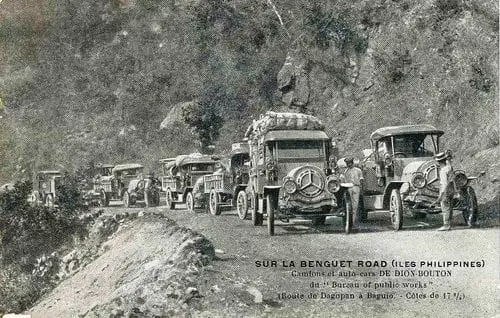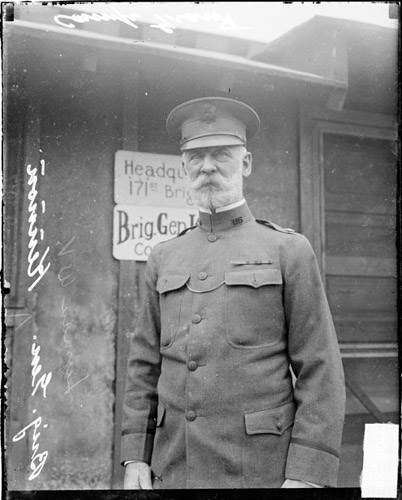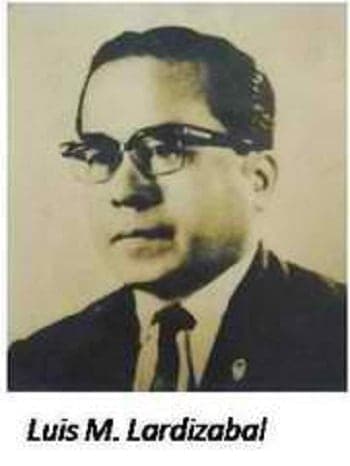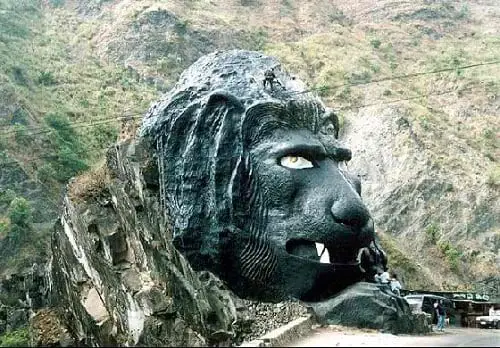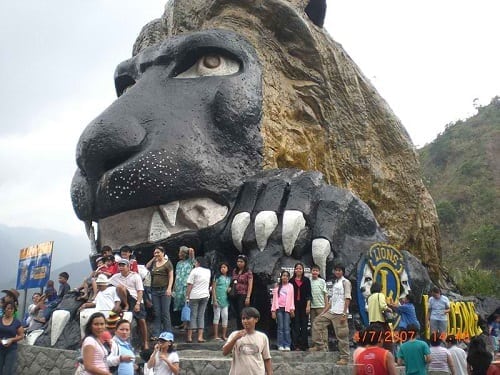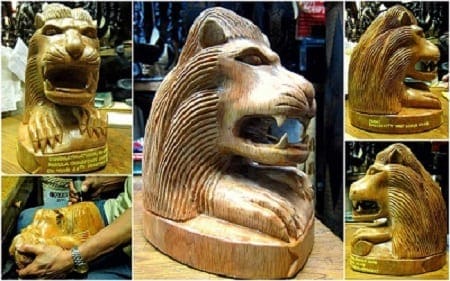The Fascinating History of Baguio’s Iconic Lion

Considered as the “King of the Jungle,” the lion symbolizes fierceness and strength. The same is true for Baguio City’s iconic lion head, although its original meaning has been obscured by time.
Today, local and foreign tourists look at it as the majestic symbol of the country’s “summer capital.”
But what is the real story behind this gigantic lion head? Who built it? And for what purpose?
Read on to find out.
Related: How to Travel to the Philippines: 50 Amazing Tourist Spots to Visit
The Star of Kennon Road
The origin of Baguio’s lion head is as colorful as the history of the road where it currently stands.
When the Americans conquered the Cordillera highland in the 1900s, they had a hard time reaching the Benguet mountains. Establishing a short route to these mountains would greatly boost the local economy, so the American government soon launched an expensive road project, much to the dismay of politicians in Washington D.C.
The Benguet Road (Kennon Road’s original name) was the most expensive engineering work at that time, costing the government a total of $2.7 million, considered excessive for that period.
Also Read: Halsema Highway – Philippines’ Deadliest Road
Despite the controversies, the project pushed through. The American government commissioned Maj. Lyman W. Kennon to complete the construction in 1905. Later, then Governor General Leonard Wood issued an executive order naming the road after Kennon.
The Baguio Lions Club
Now let’s go back to the iconic lion’s head. It was actually the brainchild of some of the pioneer members of the Baguio City (Host) Lions Club. They wanted to create a symbol that would establish the presence of the group in the area.
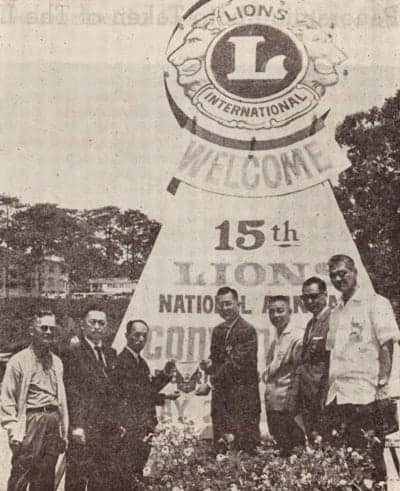
Lions Club is a service organization which aims to “meet the needs of communities on a local and global scale.” Founded in 1917 by Melvin Jones, Lions Clubs International (LCI) now boasts of 1.35 million members worldwide.
As for the name of the organization, the founder chose the lion because it stood for “strength, courage, fidelity and vital action.” At the 1919 convention, however, a member named Halsted Ritter said that the name actually “heralds to the country the true meaning of citizenship: LIBERTY, INTELLIGENCE, OUR NATION’S SAFETY.”
The influence of the socio-civic organization soon reached the Philippines. On November 21, 1950, the Baguio Lions Club was established. It was one of the first Lions Clubs founded in the country and also the first to be established north of Manila.
A Memorial of Good Deeds
From the 1950s up to the 1960s, the Baguio Lions had slowly spread Lionism in the area. Aside from recruitment, Lions Club members also led fund-raising activities for organizations like Philippine National Red Cross and the Baguio Police Department.
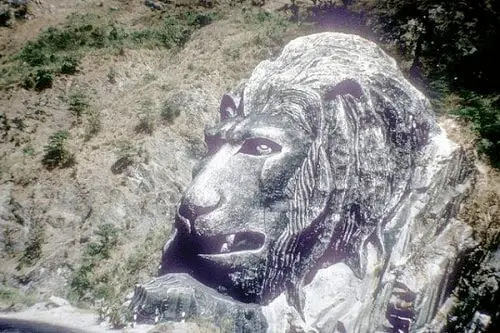
However, what literally put the Baguio Lions Club on the map were the various building and monument projects they spearheaded including the Melvin Jones Memorial Grandstand at Burnham Park, Baguio Lions Clubhouse in Governor Pack Road, Baguio War Memorial Monument, and of course, the giant lion’s head along Kennon Road.
The lion’s head was first conceptualized by pioneer Baguio Lions Club members led by Luis Lardizabal who was the mayor of Baguio from March 1960 to December 1979.
Lardizabal, who was also Lions Club governor from 1969 to 1970, sought the help of Lion members, businessmen, and those who attended the state convention to finance the project.
Also Read: The Short And Tragic Life of The First Igorota Beauty Queen
Construction of the lion’s head began in 1971 under Baguio Lions Club President and later, District 301-C Governor Robert John Webber. They commissioned an Ifugao artist named Reynaldo Lopez Nanyac to carve out the lion’s head from a limestone boulder.
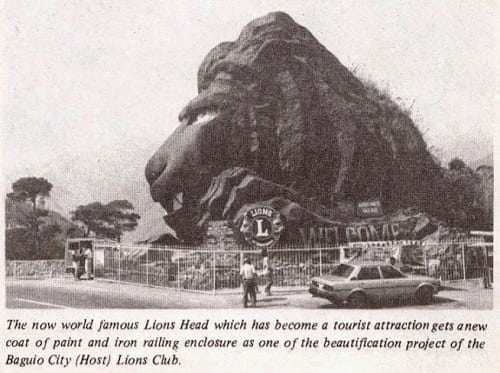
Symbolizing the influence of Baguio Lions Club in the area, the massive lion’s head was finally unveiled in 1972 under the supervision of club vice presidents Moises Cating, David Borja, and Arturo Santiago.
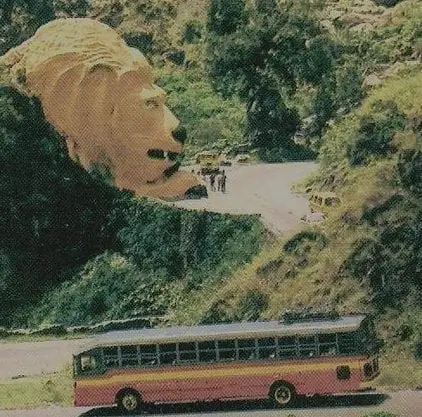
The Lion’s Head Over the Years
The face of Baguio City was not spared from the wrath of a 7.7 magnitude twin quakes that hit the city on July 16, 1990. It suffered severe cracks made even worse by vandals.
After providing assistance to those who had been affected by the earthquake, Baguio Lions Club member Alfredo de los Santos, then District 301-C Governor Gloria Vergara, and Peter Go, third vice president of the Lions Club 1991-93, led the rehabilitation of the damaged lion’s head.
Since then, the iconic structure has slowly changed its appearance and color, to the point that it began to look more like an ape than a lion. Nevertheless, tourists still stop and have their souvenir photographs taken at the base of the lion head.
The iconic structure has also helped boost the local economy, as evidenced by several woodcarving and handicraft stores that have mushroomed near the lion’s head.
In early 2014, the Regional Technical Working Group has proposed a P50 million budget to give the lion’s head a major facelift. Included in the proposal is the construction of a wider view deck, murals featuring Baguio’s history, and the transfer of souvenir stalls to a multipurpose building where a tourist information booth will also be available.
References
Agreda, J. (2014). Baguio’s Lion’s Head to get a ‘makeover’. [online] Sun Star Baguio. Available at: http://goo.gl/xGXLRU [Accessed 17 Sep. 2014].
Baguio City Host Lions Club, (n.d.). History. [online] Available at: http://goo.gl/TyOHD9 [Accessed 17 Sep. 2014].
Cabreza, V. (2012). Fighting for century-old Kennon Road. [online] INQUIRER.net. Available at: http://goo.gl/LgWicR [Accessed 17 Sep. 2014].
Caluza, D. (2000). That famous lion head along Kennon. Philippine Daily Inquirer, [online] p.18. Available at: http://goo.gl/qcH7vf [Accessed 17 Sep. 2014].
City of Pines, (n.d.). Mayors of The City of Baguio. [online] Available at: http://goo.gl/W6bp3F [Accessed 17 Sep. 2014].
Lions Clubs International, (n.d.). About Lions Clubs. [online] Available at: http://goo.gl/UAsWrs [Accessed 17 Sep. 2014].
Reyes, J. (2001). History in Baguio’s streets, landmarks. Philippine Daily Inquirer, [online] p.14. Available at: http://goo.gl/JIlE2m [Accessed 17 Sep. 2014].
FilipiKnow
FilipiKnow strives to ensure each article published on this website is as accurate and reliable as possible. We invite you, our reader, to take part in our mission to provide free, high-quality information for every Juan. If you think this article needs improvement, or if you have suggestions on how we can better achieve our goals, let us know by sending a message to admin at filipiknow dot net
Copyright Notice
All materials contained on this site are protected by the Republic of the Philippines copyright law and may not be reproduced, distributed, transmitted, displayed, published, or broadcast without the prior written permission of filipiknow.net or in the case of third party materials, the owner of that content. You may not alter or remove any trademark, copyright, or other notice from copies of the content. Be warned that we have already reported and helped terminate several websites and YouTube channels for blatantly stealing our content. If you wish to use filipiknow.net content for commercial purposes, such as for content syndication, etc., please contact us at legal(at)filipiknow(dot)net
